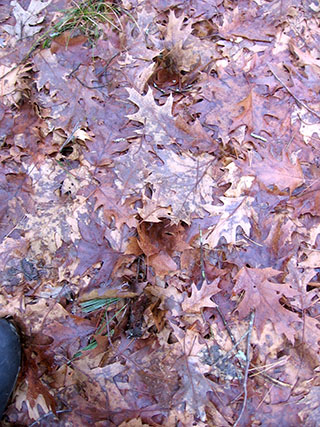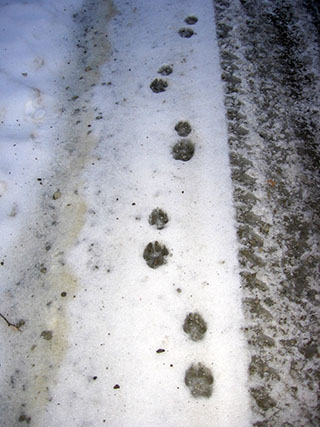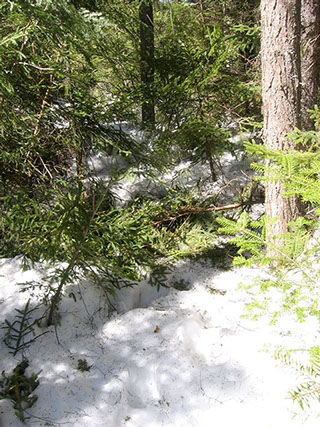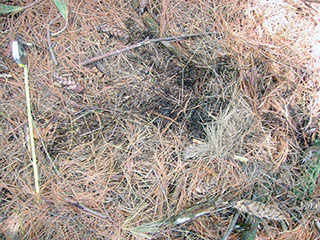
A Tracker's
TRAIL
Locating Trailing Sites
(A step-by-step process for locating a site is here.)
 White-tailed deer tracks in oak leaves that are matted and wet from snow-melt.Trailing Wildlife requires you to locate and use multiple sites that offer variety of both substrate (leaf litter vs. sand, for example) and general human interaction (e.g., suburban vs. wilderness).
White-tailed deer tracks in oak leaves that are matted and wet from snow-melt.Trailing Wildlife requires you to locate and use multiple sites that offer variety of both substrate (leaf litter vs. sand, for example) and general human interaction (e.g., suburban vs. wilderness).
You do not need “wilderness” to learn trailing. A lot can be learned with a little bit of wild ground, which is to say ground that has been taken over by the environment. It doesn’t need to be completely unmanaged, but if it looks tended or “tidy”, then for our purposes, it is not “wild” ground. There is some wild ground in New York's Central Park, but mostly no. Folks who live on very small urban/sub-urban parcels have wild ground between their houses and their shrubbery. That’s too small an area to learn trailing. So, what’s a “little bit” of wild ground? That’s a good question, but it might be less than you think. If there might be deer tracks there, it is probably big enough, but let’s move on for now, with an open mind.
One of your sites should be as convenient to your home as possible, because practice is much more likely to happen when it is convenient. If there is a private property issue that restricts how far you can go on a trail, that can still be okay: a lot of trailing practice can happen on short stretches of trail. (See references to short exercises in “Envisioning An Ideal Trailing Practice”). The site does not need to be big, but it should have wild ground, and even ¼ acre might be fine for a lot of practice. Such a spot is good for learning to see tracks, and it can be used for approximating their age, which needs regular practice in short (15 minute?) sessions. Close proximity is more important for this work than the size of the area.
 Tracks of a domestic dog in an overstep walk, a relatively common gait for many canids.Sites with sandy or snowy substrates are ideal for beginners who need to recognize track patterns, which reflect gaits and tell us so much about animal behavior.
Tracks of a domestic dog in an overstep walk, a relatively common gait for many canids.Sites with sandy or snowy substrates are ideal for beginners who need to recognize track patterns, which reflect gaits and tell us so much about animal behavior.
In addition to gait-related studies, it is especially valuable at such sites to follow deer from substrates where the tracks are clear onto other substrates, like moss or dead leaves where the tracks tend to be harder to see, because you can begin to accustom your vision to what those tracks look like. This particular line of study does not require regular practice but does require that you know the patterns and have the experience. If you can only get to these sites once in awhile, that’s okay.
When there is no snow, practice trailing as much as possible on a wild ungulate’s trails. Their hard, hoofed feet make their tracks easier to see than those of soft-footers like bears, cougars and coyotes, and the bigger the animal, the easier it will be to learn how to follow its tracks. Find a place where you can reliably find and follow the trails of deer, elk or moose.  A black bear snapped a spruce sapling to use as a mattress on snow.Many people have deer near their houses, and such a place is perfect as a home site. If you can access elk or moose trails once in awhile, that can be a great help.
A black bear snapped a spruce sapling to use as a mattress on snow.Many people have deer near their houses, and such a place is perfect as a home site. If you can access elk or moose trails once in awhile, that can be a great help.
If you happen to have a place close to home where you can reliably find elk or moose trails, do your beginner and intermediate work on those as much as possible, and shift to deer trails when you’re more advanced.
When working in snow, it’s best to trail species other than wild ungulates. In my experience with snow, I am far more likely to spook deer than to spook the other species I might trail there. For an animal, the energy loss from fleeing in deep snow can have life-threatening consequences. Also, when we try to find deer trails in snow, especially deep snow, our own trails may guide predators into a deer yard, where many animals will now be in peril.
Even if some of your sites are very similar in substrate and human presence, it is still valuable to use more than one place to practice. You don't need to trail very often in the same location for the animals to know who you are. They have a sense of your habits, where you go and when. Having alternative trailing sites helps you to mix it up and keep things fresh.
Once you are able to see tracks reasonably well in a variety of substrates and can tell the difference between old and recent trails, then it’s best to have a site for short, regular practice (20+ acres?) and one for longer practice. That’s when you might need to travel to a state park once in awhile.
See Envisioning an Ideal Trailing Practice for more.
Using Maps to Locate Sites


Google map, terrain view.
Google map, satellite view.
1 - 2
<
>
Online maps are easy to use and can quickly communicate a broad array of information. The ability to flip back and forth between satellite and terrain views makes online maps particularly helpful. You can easily see where there are fields, streams, hills (terrain-view), roads, even beaver ponds and wood roads. You can also see slope aspects (e.g., north- or south-facing) of the terrain.
There are ortho maps available online for many states, and you can often select different data sets to display. They can distinguish geological features, for example, and show you sandy areas. You can select for coniferous and deciduous cover in forest in order to predict where you might find animals that prefer one forest type to another. Aerial photos taken in winter do the same, as the
coniferous patches are green while the deciduous ones are brown. Ortho maps can display all kinds of other information as well, which some may find of additional value. Try an internet search for “ortho maps [your state]”.
If you’re looking for moose, you’re more likely to succeed in wilderness than in a suburban neighborhood. In summertime,  A Bobcat posted scent from its interdigital glands by scraping in pine needles near a pond. Sometimes they add urine marking to the mounded material.you’ll find them near water, while in winter they’re in mixed conifer-hardwood forests. Online maps can help you locate these places.
A Bobcat posted scent from its interdigital glands by scraping in pine needles near a pond. Sometimes they add urine marking to the mounded material.you’ll find them near water, while in winter they’re in mixed conifer-hardwood forests. Online maps can help you locate these places.
Where I live, bobcats especially like to eat snowshoe hares, which love the cover of coniferous thickets. Ortho maps show me likely spots. Bobcats often take porcupines, which like rocky outcrops with hemlocks or oaks, especially near wetlands. Online maps show me wetlands, steep terrain where I might find rocky outcrops, and different forest types. The maps point me the way.
Additionally, it is important to be aware of your use of private property. You may want to concentrate in state parks or land that is open to the public. Maps will show you those boundaries. Your neighbors may be amenable, though, to you trailing on their property. Ask them. It’s not a bad idea to build relations with neighbors. It’s important that they know you will respect their wishes. Don’t be too disheartened if they say no. “No” now may turn into “yes” later. You might offer something in exchange for the use of the property. Information about species' presence may be sufficient; sometimes, people are curious to know what animals prowl their place. Neighbors may become valuable allies, too, in passing information about the animals you like to trail.
So, a step-by-step process for locating a site where you can practice trailing:
-
Research the habitat preferences of the animal you wish to trail; refer to the PRG
Behavior of North American Mammals
(see
Resources)
for the specific species, or do an internet search for “deer habitat”, for example
-
Note their preferences and special requirements in terms of:
- Food
- Cover
- Landscape features
- Seasonal activity patterns (where they go in different seasons)
- Proximity to humans
-
Note their preferences and special requirements in terms of:
-
Look for that habitat in online maps, narrowing your search to public land, if necessary
- Common resources include Google Maps, Bing Maps
- Do an online search for your state’s ortho maps or other GIS (geographic information system) resources
-
Ground-truth your choice: go look for tracks and sign
- If the substrate makes it consistently difficult for you to see tracks, then it may be best to look in particular places where it is easier to see them, such as along streams or around vernal pools, places where the moisture in the ground might make the ground softer so that it holds tracks
Return to top.
© Nate Harvey, 2015